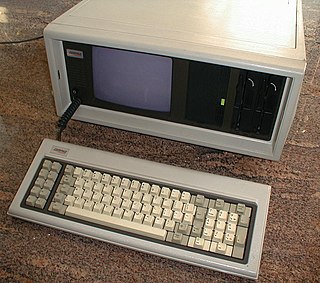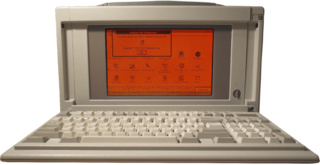
The Intel 386, originally released as 80386 and later renamed i386, is a 32-bit microprocessor introduced in 1985. The first versions had 275,000 transistors and were the central processing unit (CPU) of many workstations and high-end personal computers of the time.

The Personal System/2 or PS/2 is IBM's second generation of personal computers. Released in 1987, it officially replaced the IBM PC, XT, AT, and PC Convertible in IBM's lineup. Many of the PS/2's innovations, such as the 16550 UART, 1440 KB 3.5-inch floppy disk format, 72-pin SIMMs, the PS/2 port, and the VGA video standard, went on to become standards in the broader PC market.

The IBM Portable Personal Computer 5155 model 68 is an early portable computer developed by IBM after the success of the suitcase-size Compaq Portable. It was released in February 1984 and was quickly replaced by the IBM Convertible, only roughly two years after its debut.

The Amstrad PC1512 was Amstrad's mostly IBM PC-compatible computer system, first manufactured in 1986. Next year a slight updated version named PC1640 was introduced. It was also marketed as PC6400, and Sinclair PC500. Schneider branded machines for the German market also exists.

Compaq's first computers' form factors were portable, also called "luggables", and then "lunchbox computers", and together constituted the Compaq Portable series. These computers measured approximately 16 inches (410 mm) deep, 8 inches (200 mm) tall, and approximately 20 inches (510 mm) wide. As the products evolved, laptops and notebooks were created offing a new level of portability that caused the market to explode.

The Compaq Portable is an early portable computer which was one of the first IBM PC compatible systems. It was Compaq Computer Corporation's first product, to be followed by others in the Compaq Portable series and later Compaq Deskpro series. It was not simply an 8088-CPU computer that ran a Microsoft DOS as a PC "work-alike", but contained a reverse-engineered BIOS, and a version of MS-DOS that was so similar to IBM's PC DOS that it ran nearly all its application software. The computer was also an early variation on the idea of an "all-in-one".

The Compaq Portable II is the fourth product in the Compaq Portable series to be brought out by Compaq Computer Corporation. Released in 1986 at a price of US$3499, the Portable II much improved upon its predecessor, the Compaq 286, which had been Compaq's version of the PC AT in the original Compaq Portable chassis; Portable 286 came equipped with 6/8-MHz 286 and a high-speed 20-MB hard drive, while the Portable II included an 8 MHz processor, and was lighter and smaller than the previous Compaq Portables. There were four models of the Compaq Portable II. The basic Model 1 shipped one 5.25" floppy drive and 256 KB of RAM. The Model 2 added a second 5.25" floppy drive and sold for $3599. The Model 3 shipped with a 10MB hard disk in addition to one 5.25" floppy drive and 640 KB of RAM for $4799 at launch. The Model 4 would upgrade the Model 3 with a 20MB hard drive and sold for $4999. There also may have been a 4.1 MB hard drive included at one point. The Compaq Portable II was significantly lighter than its predecessors, the Model 1 weighed just 23.6 pounds compared to the 30.5 pounds the Compaq Portable 286 weighed. Compaq only shipped the system with a small demo disk, MS-DOS 3.1 had to be purchased separately.

MikroMikko was a Finnish line of microcomputers released by Nokia Corporation's computer division Nokia Data from 1981 through 1987. MikroMikko was Nokia Data's attempt to enter the business computer market. They were especially designed for good ergonomy.

The Contura was a line of notebook computers produced by Compaq. Released in 1992, the Contura was Compaq's first attempt at making an affordable, entry-level laptop computer.
The Commodore PC compatible systems are a range of IBM PC compatible personal computers introduced in 1984 by home computer manufacturer Commodore Business Machines.

The Deskpro 386 is a line of desktop computers in Compaq's Deskpro range of IBM PC compatibles. The computers feature Intel's 32-bit 80386 microprocessor. Introduced in September 1986, the Deskpro 386 is the first implementation of the 80386 processor in a computer system for sale to the public. It also marks the first time that a major component of the IBM Personal Computer de facto standard was updated by a company other than IBM themselves—in this case, upgrading from the 80286 processor of the Personal Computer/AT.

The Toshiba T3100 is a discontinued portable PC manufactured by Toshiba released in 1986. It features a 10 MB hard drive, 8 MHz Intel 80286 CPU and a black & orange 9.5" gas-plasma display with a resolution of 640x400 pixels.

The Compaq Portable 386 is a computer released by Compaq Computer Corporation in 1987. It was equipped with a 20 MHz Intel 80386 CPU, 1 MB RAM, 16 KB ROM, 1.2 MB5¼-inch floppy, 40 or 100 MB hard disk drive, priced at US$7,999 or 9,999 respectively, and a 10" amber gas-plasma display.

The IBM Personal Computer XT is the second computer in the IBM Personal Computer line, released on March 8, 1983. Except for the addition of a built-in hard drive and extra expansion slots, it is very similar to the original IBM PC model 5150 from 1981.

The Compaq SLT is a laptop computer that was released by Compaq. It was the first laptop released by Compaq. The SLT series was the successor to the Portable III and the predecessor to the more well known Compaq LTE. Two models were produced in the SLT series. The first model, named SLT/286, released on October 17, 1988, is considered to be one of the most notable units in laptop history due to its battery life and superior performance compared to competing models. It is also notable for being Compaq’s first laptop computer. The SLT/286 had a 12 MHz Harris or Intel 80C286 processor and a grayscale backlit VGA LCD screen, the very first laptop with this feature. The price started at $5,399 for the base-model.

The Rabbit 286 is a portable computer manufactured by Chicony Electronics starting in 1988. The computer featured an Intel 80286 clocked at 12 MHz and was available in three models, the most expensive having a 20-MB hard disk drive. The Rabbit 286, which was Chicony's first computer system, was released worldwide in April 1988. Chicony sold a bare-bones version of the computer without motherboard, which saw widespread use among systems integrators and original equipment manufacturers.

The Personal System/2 Model 30 and Personal System/2 Model 30 286 are IBM's entry-level desktop computers in their Personal System/2 (PS/2) family of personal computers. As opposed to higher-end entries in the PS/2 line which use Micro Channel bus architecture, the Model 30 features an Industry Standard Architecture bus, allowing it to use expansion cards from its direct predecessors, the PC/XT and the PC/AT. The original PS/2 Model 30 is built upon the Intel 8086 microprocessor clocked at 8 MHz; the Model 30 286 features the Intel 80286 clocked at 10 MHz.

The SupersPort is a line of PC-compatible laptops manufactured by Zenith Data Systems and sold from 1988 to 1993. The first two main entries in the SupersPort line included either an Intel 80286 microprocessor clocked at 12 MHz or an 8088 processor clocked at 8 or 4.77 MHz, switchable. Later entries included the 386SX, 486SX and 486 processors. The SupersPort 286 in particular was one of the top-selling laptops of the late 1980s, although Zenith's position in this segment faltered by the early 1990s.

The Executive Partner is an IBM PC-compatible portable computer that was introduced by the Panasonic Corporation in 1985. The portable computer is AC-powered exclusively, weighs between 28 and 30 pounds (14 kg), and features a built-in printer. The Executive Partner was one of the first affordable portable computers with a plasma display.

The LTE, LTE/286, and LTE/386s were a series of notebook-sized laptops manufactured by Compaq from 1989 to 1992. The three laptops comprise the first generation of the LTE line, which was Compaq's second attempt at a laptop following the SLT in 1988 and their first attempt at a truly lightweight portable computer. The LTE line proved highly popular—Compaq selling hundreds of thousands of units between the three—and gave way to successive generations of the line, including the LTE Lite, the LTE Elite, and the LTE 5000 series. With its use of industry-standard floppy and hard drive technologies, the LTE was the first commercially successful notebook computer and helped launch the fledgling notebook industry, which had seen earlier attempts fail due to the use of novel but nonstandard data storage.



















